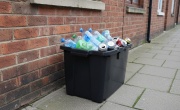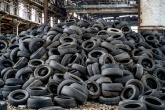EuRIC proposes five changes to European tyre recycling policy
European trade body sets targets for recycled content and export bans to strengthen circularity of end-of-life tyres.
 The European Recycling Industries' Confederation (EuRIC) has published a manifesto calling for binding recycled content targets and export restrictions to strengthen the European tyre recycling sector.
The European Recycling Industries' Confederation (EuRIC) has published a manifesto calling for binding recycled content targets and export restrictions to strengthen the European tyre recycling sector.
The organisation argues that current recycling rates remain insufficient despite the environmental benefits of mechanical recycling over incineration.
Each year, more than five million tonnes of tyres are produced in the EU, with around three million tonnes behind end-of-life tyres (ELT). Despite the EU Landfill Directive’s 2006 ban on tyre landfilling, only around 50 per cent of ELT are recycled in Europe, with the rest sent for energy recovery.
Tyre recycling into rubber granulates saves 58.4 per cent of carbon dioxide emissions compared to ELT co-incineration, and can reach 95 per cent of carbon footprint reduction when compared to virgin materials substituted, reports EuRIC.
Commenting on what needs to be done to improve this situation, Julia Ettinger, EuRIC’s Secretary General, said: “Without urgent policy action to boost domestic demand for recycled rubber or restrict the exports of unprocessed tyres, and support recyclability by design, we risk wasting valuable resources and missing our climate goals.”
Binding targets for recycled content
The organisation has called for binding targets on recycling content to drive market demand - suggesting a 10 per cent recycled rubber requirement in new tyres, and a 20 per cent requirement in automotive rubber parts.
Such targets would combat the lack of obligation for the automotive industry to incorporate recycled rubber into its products, despite being the largest consumer of rubber.
The recommendation comes as the main end-market for recycled rubber faces restrictions. Artificial turf pitches currently represent 37 per cent of the market for old tyres, but the Microplastics Restriction bans the use of plastic-based infill on these fields. According to EuRIC, recycled rubber from ELTs supplies 80 per cent of the material used for this purpose.
Export bans and harmonised standards
The second recommendation addresses the export of unprocessed waste tyres and calls for EU-wide end-of-waste criteria. EuRIC argues that when ELT are exported to countries with less stringent environmental standards, they often end up landfilled or co-incinerated.
A recent BBC investigation looked into the illegal burning of millions of tyres exported from the UK to India, finding up to one thousand unlicensed pyrolysis plants operating with ties to exported ELTs.
On harmonised standards, EuRIC points to the lack of EU-wide end-of-waste criteria despite several countries having introduced national standards. Spain, Italy and the UK have already introduced national end-of-waste criteria for recycled rubber from tyres, but harmonised criteria at EU level are crucial to remove trade and administrative barriers.
Eco-design requirements for recyclability
EuRIC’s third recommendation focuses on ensuring tyres are designed for recycling through strong eco-design requirements under the Ecodesign for Sustainable Products Regulation.
The organisation argues that recent tyre development has prioritised performance improvements over recyclability, creating serious recycling challenges.
New tyres containing sealants or noise-reducing foams cannot be sorted from normal tyres at end-of-life and are impossible to be mechanically recycled. This tyre design complexity can also lead to accidental fires in shredders.
"Considering this, the additional costs of separating and transporting these non-recyclable tyres to incineration facilities should be borne by manufacturers," the document states.
Digital Product Passports improve transparency
In order to ensure the proper disposal of ELTs, EuRIC further recommends the leveraging of Digital Product Passports (DPP) to improve data availability for efficient recycling.
"Today, information available on ELTs is purely basic and limited to sidewall markings, including the so-called DOT-number, number of textile layers, steel carcass reinforcement and tyre size. However, this information is far from sufficient for the purpose of enabling a modern DPP and therefore, efficient management and recycling," the organisation states.
EuRIC supports the use of Radio Frequency Identification technology, noting that existing technologies are already being used by some manufacturers and have proven to be relatively cost-effective for identifying tyres throughout their lifecycle.
A balanced approach to legislation
The final recommendation suggests that recent EU legislation targeting harmful chemicals should support rather than undermine the use of recycled materials.
EuRIC warns that a hazard-based approach can lead to the loss of valuable materials through downcycling, incineration, or landfilling, while also threatening the economic viability of recycling operations.
"There is a growing trend at EU level to set concentration limits for certain substances in products at extremely low levels – sometimes near-zero or below the detection limits - regardless of their intended use or actual level of exposure," the manifesto states.








